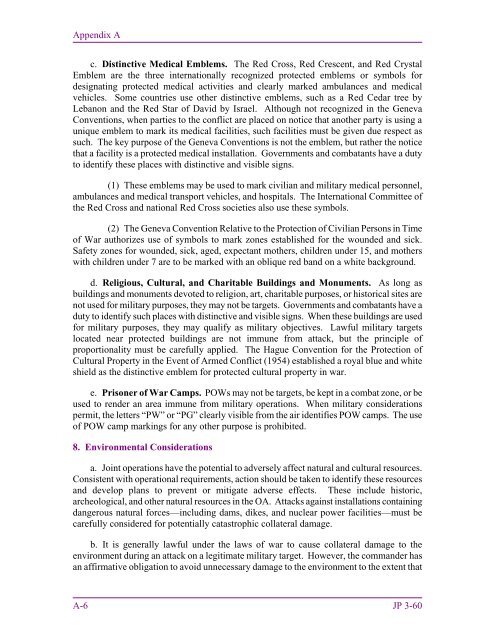Joint Targeting
1F87id9
1F87id9
You also want an ePaper? Increase the reach of your titles
YUMPU automatically turns print PDFs into web optimized ePapers that Google loves.
Appendix A<br />
c. Distinctive Medical Emblems. The Red Cross, Red Crescent, and Red Crystal<br />
Emblem are the three internationally recognized protected emblems or symbols for<br />
designating protected medical activities and clearly marked ambulances and medical<br />
vehicles. Some countries use other distinctive emblems, such as a Red Cedar tree by<br />
Lebanon and the Red Star of David by Israel. Although not recognized in the Geneva<br />
Conventions, when parties to the conflict are placed on notice that another party is using a<br />
unique emblem to mark its medical facilities, such facilities must be given due respect as<br />
such. The key purpose of the Geneva Conventions is not the emblem, but rather the notice<br />
that a facility is a protected medical installation. Governments and combatants have a duty<br />
to identify these places with distinctive and visible signs.<br />
(1) These emblems may be used to mark civilian and military medical personnel,<br />
ambulances and medical transport vehicles, and hospitals. The International Committee of<br />
the Red Cross and national Red Cross societies also use these symbols.<br />
(2) The Geneva Convention Relative to the Protection of Civilian Persons in Time<br />
of War authorizes use of symbols to mark zones established for the wounded and sick.<br />
Safety zones for wounded, sick, aged, expectant mothers, children under 15, and mothers<br />
with children under 7 are to be marked with an oblique red band on a white background.<br />
d. Religious, Cultural, and Charitable Buildings and Monuments. As long as<br />
buildings and monuments devoted to religion, art, charitable purposes, or historical sites are<br />
not used for military purposes, they may not be targets. Governments and combatants have a<br />
duty to identify such places with distinctive and visible signs. When these buildings are used<br />
for military purposes, they may qualify as military objectives. Lawful military targets<br />
located near protected buildings are not immune from attack, but the principle of<br />
proportionality must be carefully applied. The Hague Convention for the Protection of<br />
Cultural Property in the Event of Armed Conflict (1954) established a royal blue and white<br />
shield as the distinctive emblem for protected cultural property in war.<br />
e. Prisoner of War Camps. POWs may not be targets, be kept in a combat zone, or be<br />
used to render an area immune from military operations. When military considerations<br />
permit, the letters “PW” or “PG” clearly visible from the air identifies POW camps. The use<br />
of POW camp markings for any other purpose is prohibited.<br />
8. Environmental Considerations<br />
a. <strong>Joint</strong> operations have the potential to adversely affect natural and cultural resources.<br />
Consistent with operational requirements, action should be taken to identify these resources<br />
and develop plans to prevent or mitigate adverse effects. These include historic,<br />
archeological, and other natural resources in the OA. Attacks against installations containing<br />
dangerous natural forces—including dams, dikes, and nuclear power facilities—must be<br />
carefully considered for potentially catastrophic collateral damage.<br />
b. It is generally lawful under the laws of war to cause collateral damage to the<br />
environment during an attack on a legitimate military target. However, the commander has<br />
an affirmative obligation to avoid unnecessary damage to the environment to the extent that<br />
A-6 JP 3-60


